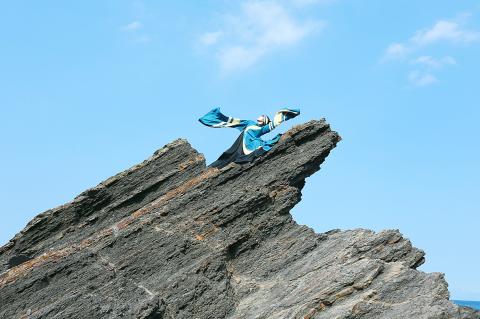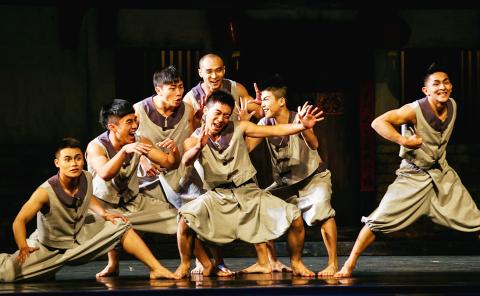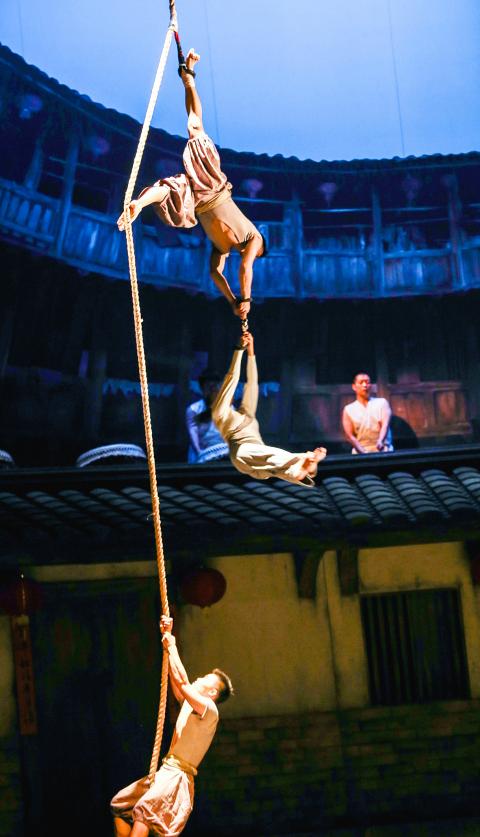The Neo-Classic Dance Company (新古典舞團) opens its new production, The Drifting Fate of Hakka (客風‧漂鳥之歌), an exploration and celebration of Hakka culture, at the National Theater in Taipei tonight for a three-show run.
The show is something of a turning point for the 38-year-old company because it was choreographed by Lu Yi-chuan (盧怡全), one of its former dancers, not the troupe’s founder and artistic director, Liu Feng-shueh (劉鳳學), the doyenne of Taiwan’s dance world.
Liu gained fame as a dance teacher, a dance scholar and something of an anthropologist. She worked for decades in National Taiwan Normal University’s physical education department and then as director of National Taiwan Arts College’s dance department — among other jobs. Her meticulous research in Japan and South Korea that helped her reconstruct the intricacies of Tang, Sung and Ming dynasty dance and music based on documents she found, as well as create new works using those styles.

Courtesy of Neo-Classic Dance Company
Her research into those old dances was part of her path toward creating “modern Chinese dance,” a form that was not heavily influenced by contemporary Western choreographers.
She also spent many years conducting research in Taiwan’s Aboriginal communities and her abiding interest in the impact of ethnic and cultural roots has influenced several of her dance productions, including 1994’s Subtlety in Ethnic Poundings (沉默的杵音) and 2009’s Land of the Clouded Leopard (雲豹之鄉), which drew on the dances and music of Amis Aborigines.
One group in Taiwan that she had not explored artistically was the Hakkas.

Courtesy of Neo-Classic Dance Company
“Hakka dance should not be confined to the Hakka traditional framework, but belongs to the world,” Liu said at a news conference earlier this year to promote the production.
While Liu has continued to teach and choreograph in the decades since she officially “retired,” at 90 she felt it was time to pass the torch to a younger choreographer while she acted as executive producer for the show and wrote the storyline.
Lu, who is himself Hakka, danced with the troupe for 11 years. In 2004, Liu encouraged him to begin choreographing. He said he drew upon both traditional and modern Hakka culture for The Drifting Fate of Hakka. Lu was known for his dynamic performances and his choreography for this production fully reflects that style.

Courtesy of Neo-Classic Dance Company
Together Liu and Lu have created a big, multifaceted production, which is divided into four acts to introduce traditional rituals, the history of the Hakka migrations and the conflicts they often faced with their neighbors and the adaptation to a modern, settled culture. The acts are titled: “Offering to the Heavens: An Eternal Dialogue Between the Heaven and Earth;” “The Way Out: A Historical Path;” “The Hakka Style: A Thousand-Year-Old Voice in Modern Tones;” and “Drifting Fate: The Drifting Bird Settles Down.”
Well-known Taiwanese composer and academic Wen-pin Hope Lee (李和莆) was drafted to compose the score for acts I, II and IV, while Hakka folksinger/rocker/songwriter Hsieh Yu-wei (謝宇威) was asked to contribute songs for Act III. Both men have won Golden Melody Awards for their works and have worked with a variety of other artists in their career. However, Hsieh said working with dancers was a new experience for him. He will be performing in Act III, alongside singer Huang Pei-shu (黃珮舒).
Lu’s action-packed work requires a lot of performers, so in addition to the company’s 16 dancers, nine students from National Taiwan College of Performing Arts’ (國立臺灣戲曲學院民俗技藝學系) Department of Acrobatics and Dance were recruited, as well as drummers and other members of the Team-Win Lion Dance Theater (廷威醒獅劇團), which was founded by Chen Chin-yi (陳晉億) and his two elder brothers in 2000.

Courtesy of Neo-Classic Dance Company
The stage set for The Drifting Fate of Hakka is stunning. It is designed to resemble a slice of a tu lou (土樓), the traditional three or four-story Hakka walled villages found in China’s Fujian and Jiangxi provinces. The multi-family structures were designed to be easily defensive, so most are circular in shape, though there are some square ones as well.
The set has a ground floor wall with three doors and a tiled roof, which masks a second-floor walkway used by the singers and occasionally the dancers. Behind this structure, a blown-up photograph of the interior of a tou lou stretches on a screen for two more stories.
There will be an introduction to the piece in the lobby of the National Theater 30 minutes before the start of each show and then the production team will take part in a question and answer session following Sunday’s matinee.

In the March 9 edition of the Taipei Times a piece by Ninon Godefroy ran with the headine “The quiet, gentle rhythm of Taiwan.” It started with the line “Taiwan is a small, humble place. There is no Eiffel Tower, no pyramids — no singular attraction that draws the world’s attention.” I laughed out loud at that. This was out of no disrespect for the author or the piece, which made some interesting analogies and good points about how both Din Tai Fung’s and Taiwan Semiconductor Manufacturing Co’s (TSMC, 台積電) meticulous attention to detail and quality are not quite up to

April 21 to April 27 Hsieh Er’s (謝娥) political fortunes were rising fast after she got out of jail and joined the Chinese Nationalist Party (KMT) in December 1945. Not only did she hold key positions in various committees, she was elected the only woman on the Taipei City Council and headed to Nanjing in 1946 as the sole Taiwanese female representative to the National Constituent Assembly. With the support of first lady Soong May-ling (宋美齡), she started the Taipei Women’s Association and Taiwan Provincial Women’s Association, where she

It is one of the more remarkable facts of Taiwan history that it was never occupied or claimed by any of the numerous kingdoms of southern China — Han or otherwise — that lay just across the water from it. None of their brilliant ministers ever discovered that Taiwan was a “core interest” of the state whose annexation was “inevitable.” As Paul Kua notes in an excellent monograph laying out how the Portuguese gave Taiwan the name “Formosa,” the first Europeans to express an interest in occupying Taiwan were the Spanish. Tonio Andrade in his seminal work, How Taiwan Became Chinese,

Mongolian influencer Anudari Daarya looks effortlessly glamorous and carefree in her social media posts — but the classically trained pianist’s road to acceptance as a transgender artist has been anything but easy. She is one of a growing number of Mongolian LGBTQ youth challenging stereotypes and fighting for acceptance through media representation in the socially conservative country. LGBTQ Mongolians often hide their identities from their employers and colleagues for fear of discrimination, with a survey by the non-profit LGBT Centre Mongolia showing that only 20 percent of people felt comfortable coming out at work. Daarya, 25, said she has faced discrimination since she